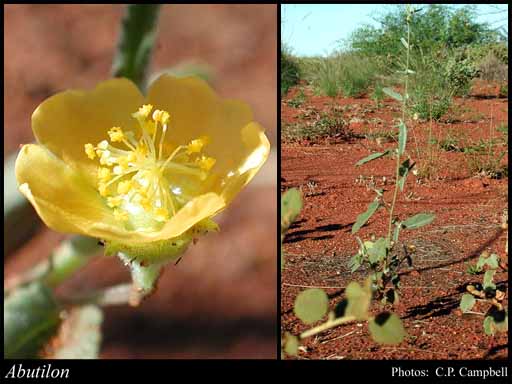- Reference
- Gard.Dict.Abr. 3 (1754)
- Name Status
- Current

Scientific Description
Common name. Lantern Bushes. Family Malvaceae.
Tribe Malveae.
Habit and leaf form. Shrubs, or herbs (generally with a stellate indumentum). Plants unarmed. Annual, or perennial; to 0.4–3 m high. Mesophytic. Not heterophyllous. Leaves small to medium-sized; alternate; spiral; petiolate; non-sheathing; simple. Leaf blades dorsiventral; dissected (3–5-lobed), or entire; ovate, or oblong, or elliptic, or orbicular; palmately veined; cordate. Mature leaf blades adaxially pubescent; abaxially pubescent. Leaves with stipules (stipules linear or subulate). Stipules caducous. Leaf blade margins entire, or crenate, or serrate. Leaf anatomy. Hairs present; complex hairs present. Complex hairs stellate. Extra-floral nectaries absent.
Reproductive type, pollination. Fertile flowers hermaphrodite. Unisexual flowers absent. Plants hermaphrodite. Entomophilous.
Inflorescence and flower features. Flowers solitary (often appearing as a leafy panicle or raceme due to decrescence of upper leaves); axillary; pedicellate (pedicels articulate in the upper half); small to medium-sized; regular; 5 merous; tetracyclic. Hypogynous disk absent. Perianth with distinct calyx and corolla; 10; 2 -whorled; isomerous. Calyx present; 5; 1 -whorled; gamosepalous; lobed; lobulate (5-lobed); hairy; valvate; exceeded by the corolla, or more or less equalling the corolla, or exceeding the corolla; more or less campanulate; regular; persistent; accrescent (sometimes enclosing the schizocarp). Calyx lobes ovate. Epicalyx absent. Corolla present; 5; 1 -whorled; polypetalous (tubiform, adnate to the base of the staminal column); glabrous abaxially; glabrous adaxially; white, or yellow (mainly), or orange. Petals obovate. Androecium present. Androecial members indefinite in number. Androecium 50–100 (i.e. ‘many’). Androecial members adnate; all equal; coherent (connate; the filaments fused in a column surrounding the style); 1 - adelphous (the tube attached to the petals); 1 -whorled. Androecium exclusively of fertile stamens (or rather, half-stamens, each having only a half anther). Stamens 50–100. Anthers dehiscing via longitudinal slits; introrse; unilocular. Gynoecium 5–40 carpelled (in a single whorl). The pistil 5–40 celled. Gynoecium syncarpous; synstylovarious to eu-syncarpous; superior. Ovary plurilocular, or unilocular (rarely and due to abortion); 3–9 locular. Gynoecium stylate. Styles 1; more than 4-branched (5–40 branched, filiform to clavate); apical. Stigmas 5–40 (slender or thickened towards the apex); capitate. Placentation axile. Ovules 3–9 per locule.
Fruit and seed features. Fruit non-fleshy; hairy; a schizocarp (globular to cylindrical; separating septicidally into 2-valved dehiscent mericarps leaving a persistent central axis). Mericarps 5–40. Dispersal unit the mericarp (chartaceous, laterally compressed, reniform in outline with the outer edge obtuse, acute or awned). Fruit 3–27 seeded. Seeds 1 per mericarp to 2 or more per mericarp (i.e. 1–9). Seeds conspicuously hairy, or not conspicuously hairy.
Geography, cytology, number of species. World distribution: pantropical. Native of Australia. Not endemic to Australia. Australian states and territories: Western Australia, South Australia, Northern Territory, Queensland, New South Wales, Victoria, and Australian Capital Territory. Northern Botanical Province. A genus of c. 100–150 species; 27 species in Western Australia.
Etymology. Name used by Avicenna (see Avicennia) for a plant of this or some allied genus of the mallow family.